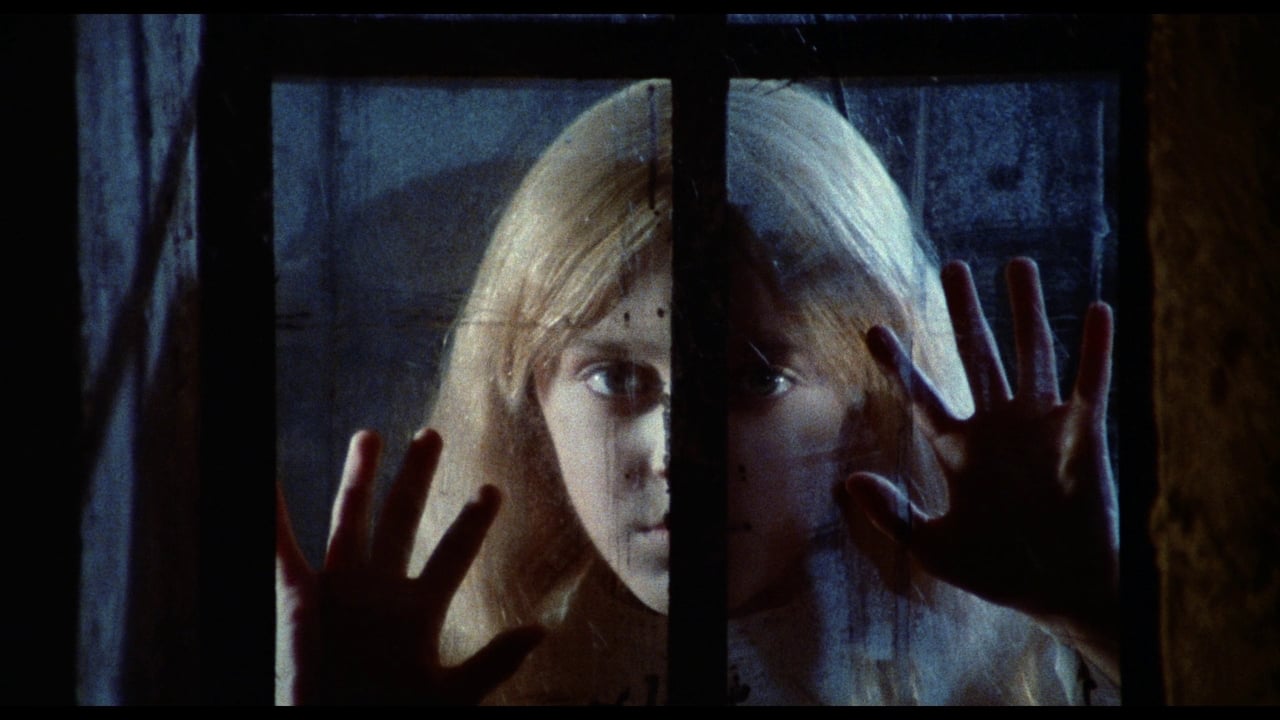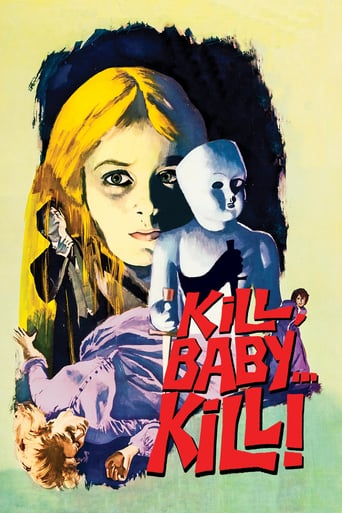

Truly Dreadful Film
... View MoreBetter Late Then Never
... View MoreA story that's too fascinating to pass by...
... View MoreThe film's masterful storytelling did its job. The message was clear. No need to overdo.
... View MoreRELEASED IN 1966 and directed by Mario Bava, "Kill, Baby, Kill" takes place in a Carpathian village in 1907 where Dr. Paul Eswai (Giacomo Rossi-Stuart) arrives to perform an autopsy at the request of the inspector (Piero Lulli). The evidence points to the hamlet being cursed with a mysterious ghost girl that compels those who see her to kill themselves, which the doctor thinks is rubbish; at first anyway. Erika Blanc plays a visiting medical student who assists Eswai while Fabienne Dali appears as the village witch and Giovanna Galletti as a bitter baroness. Luciano Catenacci is on hand as the burgomaster (mayor) and the witch's lover.The movie has a colorful and haunting Gothic/Horror ambiance, which can be traced to earlier films like the B&W "The City of the Dead" (aka "Horror Hotel") (1960) and, more so, "The Terror" (1963), which was one of Francis Ford Coppola's early works, although he only directed part of it. Like those flicks, "Kill, Baby, Kill" features mysterious manors, dilapidated churches, ghosts, cobwebs, witches and bell towers in the mold of Hammer flicks of the era, such as the contemporaneous "Dracula, Prince of Darkness" (1966). As far as spooky MOOD goes, "Kill, Baby, Kill" is superb, but the story isn't as compelling as "The Terror," except for the last act. Nevertheless, the movie has influenced many artists and their works.Rossi-Stuart makes for a stalwart protagonist in the mold of James Bond (looks-wise) while Erika Blanc and Fabienne Dali work well on the other side of the gender spectrum, both striking in different ways.The title of the film is cheesy and recalls Russ Meyer's "Faster, Pussycat! Kill! Kill!" from the year before. It was obviously used to give the film a "hip" edge and sell as many tickets as possible. In 1971 it was retitled "Curse of the Living Dead" in the US, which was a 100% improvement. Here are several other sample titles that would be an upgrade, as well as more accurate: "Village of the Laughing Dead"; "Night of the Laughing Dead"; "Child of Vengeance"; "The Ghost at the Window"; "Child Cursed Village"; "Forgotten Daughter"; "Make them Pay"; "Sorceress' Regret"; "Melissa"; and "Melissa's Curse."Okay, now for a few joke titles: "Melissa and her Sissa"; "The Graps of Wrath"; "That Damn Ball" and "Ghost Boy in Drag." That last one is due to the fact that the ghost girl was played by a boy, one-shot actor Valerio Valeri.THE MOVIE RUNS 1 hour, 23 minutes and was shot entirely in Rome, Lazio, Italy. WRITERS: Romano Migliorini, Roberto Natale and Bava.GRADE: B
... View More"Kill, Baby, Kill!" also known under its original Italian title, "Operazione paura" ("Operation Fear") follows a doctor who is dispatched to a remote village in the Carpathian mountains to perform an autopsy on a woman who died under unusual circumstances in an abandoned church. When he arrives, he is met by superstitious locals who credit a ghostly young girl with the death, along with numerous others that have plagued the town.One of Mario Bava'a greatest Gothic achievements, "Kill, Baby, Kill" has a wide-reaching influence that is almost unmatched in the horror genre. Not only has it been visually influential, but the narrative has functioned as a model for just about every Gothic "outsider enters supernatural situation" horror flick to follow it. Influence aside, the film has been credited by many as Bava's greatest achievement, and they may be right; I can't patently say one way or the other. However, I do believe it is undoubtedly one of the greatest horror films of its decade, and among the all-time greats.As is the case with anything Mario Bava had his hands on, the film is visually stunning, but "Kill, Baby, Kill" seems even more colorful and striking than many of his other pictures—imagine "Black Sunday" in Technicolor. The foggy sets and baroque aesthetics of the village are immediate and steeped in atmosphere, while the motifs of the blonde ghostly little girl and broken Victorian dolls as arbiters of doom are legitimately chilling.The performances here are by and large strong, with Giacomo Rossi Stuart as a suitable leading man, and Erika Blanc as the mysterious Monica. Fabienne Dali is also quite memorable as the vampy good witch. More than anything else, though, "Kill, Baby, Kill" has likely upheld its reputation because it simply has a compelling story that audiences still recognize (likely due to the aforementioned, wide-ranging influence). It's a classic story that boasts a substantive air of mystery and even a few unexpected revelations. The finale does feel a bit ham-fisted in that it relies on dialogue quite a bit and is also rather brisk, but this is more or less telling of the era in which it was made than a legitimate fault.All in all, "Kill, Baby, Kill" is a deserved genre classic. Not only does it offer Bava's signature dreamy visuals and popping colors, but it also brings enough mystery and narrative intrigue to keep one compelled. It's a classic story told in a classic way, and it to this day presents some of the most chilling images the horror genre has ever offered. 10/10.
... View MoreThe first thing I want to mention is I do not like the American title "Kill, Baby, Kill" - it's sounds very cheesy. The film is not as cheesy as the title suggests. It would do better with a simple title like maybe "The Girl" or "The Ghost" -- but what do I know? LOL.It's all eye candy and little story to me. The little ghost girl shows up and people kill themselves. The older woman in the mansion knows the story behind the girl.The story is drawn out a bit to long - could have been shorter. There are some boring scenes that could have been left out all together or shortened.This is another movie I wanted to like better than I do.4.5/10
... View MoreFrequently lauded and cited as a strong influence by the likes of Martin Scorsese, Federico Fellini and David Lynch, Kill Baby, Kill is, along with the 1963 Bronte/Sade opus Whip & the Body, the most oft-mentioned crowning achievement of Mario Bava. Those who saw Kill Baby, Kill upon its initial release (as is the case with the three auteur mentioned above) witnessed something heretofore unseen in Italian Horror, if not in cinema as a whole. Never before had a low-budget, commercial and studio film been obviously and primarily concerned with its style, perhaps purposefully to the sacrifice of all else. The producers ran out of money two weeks into shooting, but Bava and the entire cast/crew decided to keep working for free. I'd like to think that this explains the film's aesthetic – the idea that the producers (out of shame for having no money) left the artists alone to do whatever they wanted. Who would they be to demand re-shoots with no money to pay anyone?And what style is this movie? Rural rococo? Barnyard baroque? Not since the heyday of Sternberg and Murnau had a film director been so obvious about his single-minded conveyance of artifice über alles. Ahem I'd go so far as to call it The Scarlet Empress of Italian Horror. (Hopefully Marlene Dietrich and Jack Smith aren't rolling over in their graves from that one.) It's as if Bava were contractually obligated to tell a story or have a plot in this film (he's one of the three screenwriters on this one by the way), but all he really wanted to do was perfect using his purple and green fill lights, maybe show off his exquisite low-key techniques, and go zoom-shot reverse zoom-shot 'til one's head is spinning. Oh yeah, and that new industrial-sized dry ice machine – don't forget to leave that on full blast.The plot, which is amusingly influential in its own right, concerns the giggly, ball-bouncing ghost of an accidentally killed little girl who, through the vengeful psyche of her psychotic albeit medium mother, is terrorizing all the villagers into guilt-ridden suicide, one at a time. Though the mayor and his good-witch girlfriend-on-the-side are trying their best to outdo the nasty matron and her brat, all is so far for naught. All this is happening because the debauched and ignorant villagers were busy partying and sinning during an all-night drunken holiday, and they didn't notice that the girl (little Melissa), the Baroness Graps' daughter, was in danger. For poor Melissa got trampled by horses, and her attempt to call attention to her not-yet mortal wounds via the ringing of the town bell, fell upon gin-soaked eyes and ears. The mournful Baroness seeks revenge, and, with the help of her spectral spawn, her plan is succeeding nicely. Friday the 13th anyone ?The Villa Graps, where the delightfully paranoid Baroness resides, is (along with William Burroughs) a clear influence on Twin Peaks' Black Lodge, with the Baroness herself (as was pointed out to me by a Kill Baby, Kill obsessed friend) the undeniable source of Grace Zabriske's genius performance as Laura Palmer's mother. Like the Black Lodge, the Villa Graps is a maddening character in its own right. And as for the banal screenwriters of the already mentioned Friday the 13th, after seeing Kill Baby, Kill and Bava's later Twitch of the Death Nerve you too may wonder why a lawsuit was never filed against them. The stunning visuals, the beautiful tracking shots, the creepy laugh of Melissa, the Baroness' hair, the pure and absurd phantasmagoria of it all – Kill Baby, Kill is Bava's ultimate proof that style could attempt to be substance all by itself. And though he denied the identity of 'artist' his whole life (he preferred 'craftsman' or 'artisan'), with this film Bava proved that his instincts and impulses were in line with the greatest attribute an artist can ever hope to have: that of risk-taker.
... View More